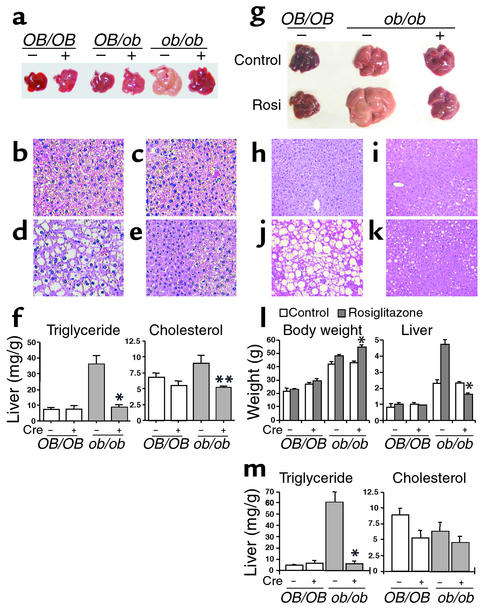Figure 2.
Effect of hepatic PPARγ deficiency in ob/ob and OB/OB mice. (a–f) Nontreatment mice. (a) Liver of littermates. Livers of 8-week-old mice were used. (b–e) Histology of livers from OB/OB-PPARγ(fl/fl)AlbCre– (b) and ob/ob-PPARγ(fl/fl)AlbCre– (d) or OB/OB-PPARγ(fl/fl)AlbCre+ (c) and ob/ob-PPARγ(fl/fl)AlbCre+ mice (e). H&E staining was performed for liver sections (original magnification, ×100) from each genotyped mouse. (f) Total cholesterol and TG content in OB/OB-PPARγ(fl/fl)AlbCre– (n = 5: 2 males and 3 females), OB/OB-PPARγ(fl/fl)AlbCre+ (n = 4: 2 males and 2 females), ob/ob-PPARγ(fl/fl)AlbCre– (n = 6: 3 males and 3 females), and ob/ob-PPARγ(fl/fl)AlbCre+ (n = 15: 8 males and 7 females) mice. (g–m) Rosiglitazone-treated mice. (g) Rosiglitazone-treated livers. (h–k) H&E staining of livers from rosiglitazone-treated OB/OB- PPARγ(fl/fl)AlbCre– (h) and ob/ob-PPARγ(fl/fl)AlbCre– (j) or OB/OB- PPARγ(fl/fl)AlbCre+ (i) and ob/ob-PPARγ(fl/fl)AlbCre+ mice (k). (l) Body and liver weight in rosiglitazone-treated and control mice. For control groups: OB/OB-PPARγ(fl/fl)AlbCre–, n = 4 (2 males and 2 females); OB/OB-PPARγ(fl/fl)AlbCre+ (n = 3, males); ob/ob-PPARγ(fl/fl)AlbCre–, n = 7 (3 males and 4 females); and ob/ob-PPARγ(fl/fl)AlbCre+, n = 5 (3 males and 2 females). Rosiglitazone groups: OB/OB-PPARγ(fl/fl)AlbCre–, n = 5 (2 males and 3 females); OB/OB-PPARγ(fl/fl)AlbCre+, n = 4 (3 males and 1 female); ob/ob-PPARγ(fl/fl)AlbCre–, n = 10 (6 males and 4 females); and ob/ob-PPARγ(fl/fl)AlbCre+, n = 9 (5 males and 4 females). (m) Total cholesterol and TG content in rosiglitazone-treated mice. The mouse number for each genotype was described in l. Data are mean ± SE. *P < 0.001, **P < 0.01 compared with Cre– mice. Rosi, rosiglitazone.

